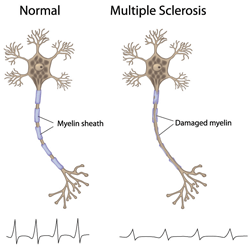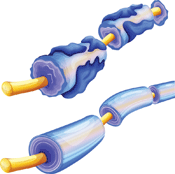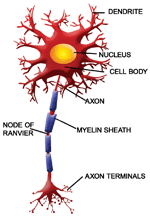The Multiple Sclerosis Process and Symptoms
Multiple sclerosis (MS) is a disease of the central nervous system (CNS). The CNS consists of the brain, optic nerves and spinal cord. With MS, areas of the CNS become inflamed, damaging the protective covering (known as “myelin“) that surrounds and insulates the nerves (known as “axons“). In addition to the myelin, over time, the axons and nerve cells (neurons) within the CNS may also become damaged.
The damage to the protective covering and also to the nerves disrupts the smooth flow of nerve impulses. As a result, messages from the brain and spinal cord going to other parts of the body may be delayed and have trouble reaching their destination – causing the symptoms of MS.

Shown above is an illustration of two nerve cells. The normal one on the left has a healthy nerve fiber, or axon, protected by myelin (insulation covering the nerve), and is able to transmit signals at a very fast speed – similar to electricity traveling along an electrical cord. The ms nerve cell on the right shows damage to the myelin, and as a result, signals do not travel well along the nerve.

When the myelin becomes damaged (as shown in the top illustration), or the nerve itself becomes damaged, signals can no longer travel across the nerve fiber efficiently. As signals slow down or are lost, the body cannot respond appropriately – causing the symptoms of ms.

Shown above is an illustration of a nerve cell. The nerve fiber, or axon, when protected by healthy myelin, is able to transmit signals at a very fast speed – similar to electricity traveling along an electrical cord.
Common symptoms include:
- anxiety
- balance
- bladder dysfunction
- bowel problems
- cognitive changes
- depression
- dizziness/vertigo
- fatigue
- mobility and walking issues
- numbness
- pain
- Pseudobulbar Affect (PBA)
- sexual dysfunction
- sleep issues
- speech difficulties
- spasticity (stiffness)
- swallowing disorders
- tremor
- visual disorders
- weakness
Areas of inflammation and damage are known as “lesions.” The changes in size, number, and location of these lesions may determine the type and severity of symptoms. While individuals with relapsing forms of MS are believed to experience more inflammation than those with progressive forms of MS, lesions still occur for individuals with all forms of MS. However, the lesions in progressive forms of MS may be less active and expand more slowly.
In addition to symptoms, disease activity may be evaluated from changes in the size or number of lesions. Frequently, MS may be “clinically silent,” showing no increase in symptoms, yet continuing to show signs of disease activity within the CNS. For individuals with relapsing forms of MS, early and continued treatment with a disease-modifying therapy (DMT) can often slow the “clinically silent” disease activity in the brain, reducing the size and number of active lesions. This is why most neurologists, as well as the American Academy of Neurology, recommend that individuals with relapsing forms of MS begin treatment as soon as possible after the diagnosis is established. More recent FDA approvals have brought new DMTs that also treat active secondary-progressive MS and primary-progressive MS.
Additionally, areas of thick scar tissue may eventually form along the areas of permanently damaged myelin. These areas of scar tissue are referred to as “plaques.” The term “multiple sclerosis” originates from the discovery of these hardened plaques. Multiple refers to “many;” sclerosis refers to “scars.”
Lesions and plaques are viewed on a magnetic resonance imaging (MRI) scanner. This technology is used to help diagnose MS and evaluate its progress at various intervals.
